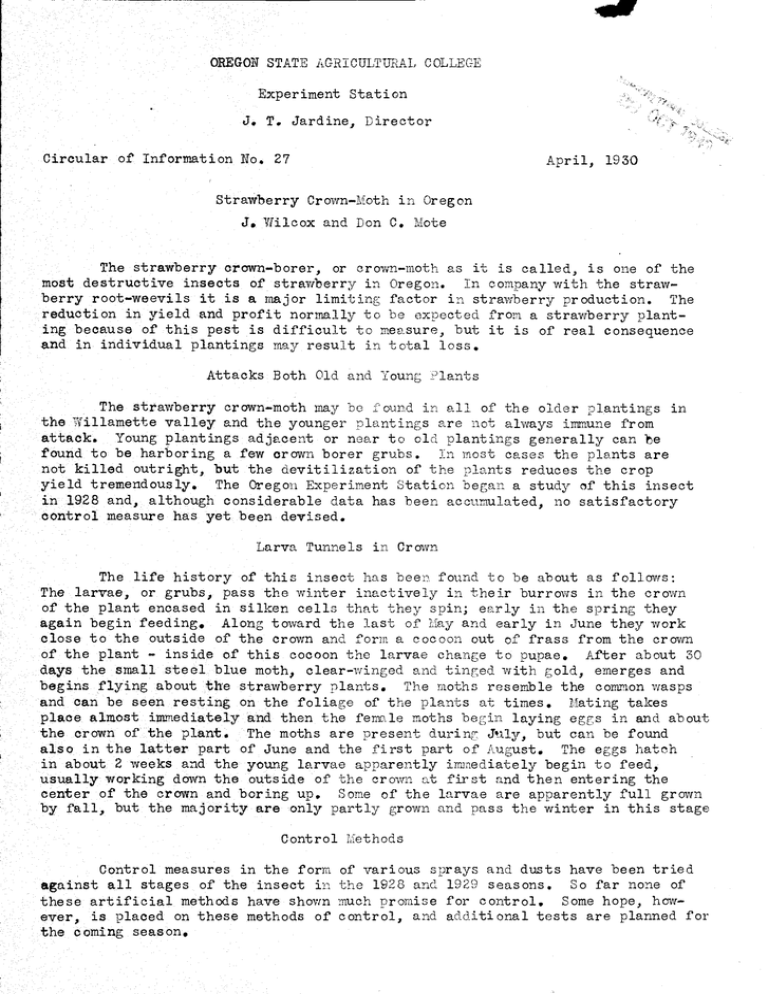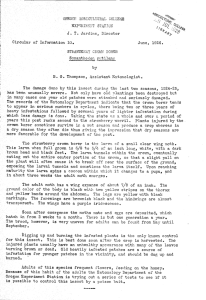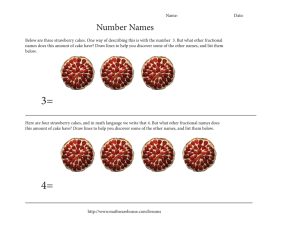J. T. Jardine, Director
advertisement

OREGON STATE AGRICULTURAL COLLEGE Experiment Stat ± J. T. Jardine, Director Circular of Information No. 27 April, 1930 Strawberry Crown-Moth in Oregon J. Wilcox and Don C. Mote The strawberry crown-borer, or crown-moth as it is called, is one of the most destructive insects of strawberry in Oregon. In company with the strawberry root-weevils it is a major limiting factor in strawberry production. The reduction in yield and profit normally to be exoected fron a strawberry ulant- ing because of this pest is difficu]t to meosure, but it is of real consequence and in individual plantings may result in total loss. Attacks Both Old and Young Plants The strawberry crown-moth may be found in all of the older plantings in hntings re ot always inriune from attack. Young plantings adjecent or fleer to olc plantings generally can be found to be harboring a few crown borer grubs ost cese the plonts are the illamette valley and the younger I not killed outright, but the devitilization of the plants reduces the crop yield tremendously. The Oregon Experiment tatio bege.n a study of this sect in 1928 and, although considerable data has been accnnulated, no satisfactory control measure has yet been devised. Larva Tunnels in Crown The life history of this insect has been found to be about as follows: The larvae, or grubs, pass t1e wiPoer inoctively in their burrows in the crown of the plant encased in silken cells that they spin; early in the spring they again begin feeding. Along toward the last of May and early in June they work close to the outside of the crown and form a cocoon out of frass from the crown of the plant - inside of this cocoon the larvae chage to pupae. After about 30 days the small steel blue moth,, clear-winged ann tinged with gold, emerges and begins flying about the strawberry plants. The moths rrserible the comrion wasps and can be seen resting on the foliage of the planbs af tines. Uating takes place almost immediately and then the fenmle moths bei"i laying eggs in and about the crown of the plant. The moths are oresent during J'ly, but car be found also in the latter part of June and the first part of Jugust. The eggs hatch in about 2 eeks and the young larvae aunarently innediately begin to feed, usually working down the outside of the crowr ot first nd then entering the center of the crown and boring Un, orie of the l'irvae are apparently full grown by fall, but the mijority are only partll growr' and oss the winter in this stage Control Methods Control measures in the form of various sprays and dusts have been tried sgainst all stages of the insect in the 1928 and 1929 seasons. So far none of these artificial methods have shown much promise for control. Some hope, however, is placed on these methods of control, and additional tests are planned for the coming season. 2. Plowing In cultural niet'nods of control a little more success was attained. The old reconmiendation for control was to piow u a atch iofested witl borers and to gather up the plants and burn thor'. This is, of co'rse, tie surest 'tay to kill the borers, but in our tests we have found. that by plowing the plants in the fall and planting to grain, that over 90% of the borers wil be killed b soring. Also by ploing early in eptember and leaving the plants or ton of the ground, 00% of the borers were found to have been hilled before rinter set in. Tpping Preliminary experiments with topping also gave some encouraging results. Two patches were used in these tests, both were arshalls, which the 1929 season was the first crop year. In both cases it was necessary for the moths to fly over the topped plants to get to the untopped plants. In one potch where there was a light infestation, e found alart in 100 of the topped plants infested ith borers, while nraeticall'r every 1ant in the untopped part of the patch was infested. In anothoi patch heavily infested edjacent to the 1 year old patch, in 10 plants from the tor'ped portion we found 4 borers, and in 10 plaiits from the untapped ortio' lire found 10 borers it r'ay he added that in the adjacent petch (3 yeir btersourg) 40 ad 50 crers oer alant iiere commonly found in each plvit and i on lant 90 boreis ' ere found. The evidence regarding topping is rather meager and considerable experimeriting remains to be done. It 'inpears, ho vever, chat e 'rna use our experience In a field heie there is a "ucoession of plants or pahes according to age, as settings, one, two and three years old, the one with topping as follows and two year old patches would be topped immediately after harvest; the 3 year old patch left with the tops on for the moths to concentrate on, and this patch could be plowed in the fall and thereforo most of blie larvae be destroyed. A sharp butôher knife or sickle seems to be the best tools to top with. All the leaves can be cut off clean immediately after harvest, care being taken good many g ower' use a mo nn machine bub iith varying not to cut the crown. results, in many cases more barn than good oelrg done.




